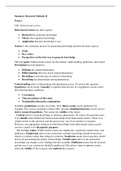Summary
Summary Research Methods II Year 2.5 Psychology
- Course
- Institution
- Book
This is a summary for the course Research Methods II of the second year of psychology. The summary is based on the book Principles of Research in Behavioral Science by Mary E. Kite and Bernard E. Whitley Jr. and information from the lectures and tutorials. I studied using this summary and received ...
[Show more]






